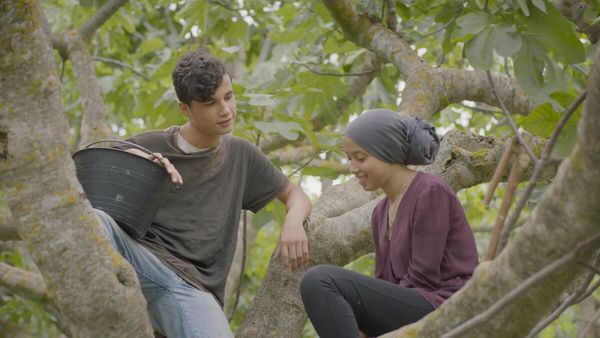 |
| Fide (Fide Fdhili) in Under The Fig Trees. Erige Sehiri: 'It was not about the beauty of the place but the beauty of them and that's what I wanted to focus on' |
“I found that I liberated myself a bit from documentary, from reality,” says Sehiri, when I catch up with her on Zoom, “but at the same time, it's very grounded in the reality. So it's like in between.” She adds: “In real life, these women who work on the farm the whole year, the older women, and the younger women, who come to join during vacation and summertime, they often fall victim to these pick-up trucks this pickup trucks – fall out from the truck – and we call them ‘the truck women’.
“So these accidents are something that is happening every few months. And it has happened for years and nothing has changed. And that was a way in for me, even though it's not in the film. It's kind of how I got inspired, by how to imagine this last day. And when I think about this last day, maybe before a truck accident, I realised that it will be like any other day. Because life is casual, it’s how it is every day and they don't know if this is going to be the end. And that's the same for all of us, we don't know. So which means that everything is important on that day. And so that's how I with a background, I started to build something that is very, very dear to me.”
It’s interesting that the director – who previously made documentary Railway Men – was inspired by something so tragic because the film, although painting a less than glowing picture of the patriarchal situation in Tunisia, has an overall positive vibe, especially in terms of the women’s solidarity with one another.
Sehiri says: “I think it's not that it's positive, it's just that's the way people are actually. They're living drama every day, they don't have enough money, they have to do denunciation to survive. But that's a common casual life, at the same time, they have to live like that. And so life is much better when we smile and have fun and find some freedom in this because you have to survive. I just feel that's how people are actually, especially Tunisian people, I think that they are like that.”
Throughout the day, we see how the older women and the younger women have different roles in the orchard but nevertheless a sort of intergenerational solidarity emerges, highlighted when one of the older female workers has an opportunity to denounce one of the younger women to her boss but elects not to.
Sehiri explains: “I think it's because it's a film about connection and relationships and a common destiny. And that's what the truck is representing, that they go into the truck and they go back together and the truck, young, old, men and woman - all of them are have this common destiny and this connection is what makes people you know, go through life.
The filmmaker worked on the script with Peggy Hamman and, notably, Ghayla Lacroix, who has previously worked on films including Blue Is The Warmest Colour and Couscous with Abdellatif Kechiche – films that share a similar naturalistic sensibility to Sehiri’s.
 |
| Director Erige Sehiri: 'I'm inspired by grounded, real-life stories, and I like to maybe to find some poetic side of it, or lyrical side of that' Photo: Elise Ortiou Campion |
This sort of connection seems to have been vital off-screen as well as on it, especially because Sehiri was working with non-professionals on the film, which involved a lot of back and forth and improvisation. She notes that, for example, kissing scenes were avoided in favour of something more suggestive than direct in order to respect her cast. She explains: “I could not make the women kiss a man because after the film, they will go back to their house and to their parents. I used that as a sensual aspect in the film. You don't have to show everything to be sensual and to be romantic. I had to adapt, I had to adapt and had to use that in a good way.”
Sehiri was also able to forge a deep connection with the cast because the fig harvest is a short one, lasting just one month, which meant they had to shoot over two consecutive years.
She says: “That was the biggest challenge, to keep that energy even though the people changed throughout the year.”
Sehiri adds: “They were not acting, but they were playing and that was really important for me, because what I wanted also is to build this orchard like it’s a stage where I can give voices to non-actors with a specific accent from a specific region that we never hear in cinema. But at the same time, that it was a good moment for them to play a role. In the beginning, it was a bit sensationalist, like they were playing in TV series, you know. But then little by little, because of the connection they were building with each other out of the shoot, we really felt like a theatre troupe.”
Although the finished film is anything but theatrical, there is something Shakespearean about some of its themes and the way in which there’s a sense of the normal rules of life not applying away from the villages in the relative freedom of the orchard. Also there’s an interplay between gender roles that is less than conventional. Where preconceptions might lead audiences to think it would be men enforcing a sort of ‘gender’ order on things, here we also see how one young woman wants a man who follows the societal traditions – so that it’s not men or women who are specifically shaping these roles but society as a whole that is trapping people within its conventions.
“That's how I wanted to build this metaphor of the Tunisian society, or the Arab society or whatever,” says Sehiri “The idea of having these different women and men and generations. It's not it's not about gender, it's really about society, how it's built, and how each one of us is suffering from this system, or this mentality that was transmitted to us. And the men also, of course, it was really important for me to give them a voice in this film.”
Music is used sparingly in the film, but arrives at key moments, including during a break in the work day when a woman, Leila, sings – in words that are not subtitled – about loss.
Sehiri explains: “It’s a traditional song. It was really someone who was in the orchard, who had this flute, which they something use for a break. e and do something and she improvised.”
“I think emotion and connection is not about translations. What happened is that when she started to sing, she's singing with specific dialect, so we didn't understand everything she was saying, but we could feel what's inside her we could feel what she's crying about. Love or something lost. And then the other character starts to cry for real in the scene. And the technician started to cry while we were shooting that that scene that was a beautiful moment for us an unforgettable moment.”
Initially, Sehiri wasn’t planning on having a score at all but then she changed her mind. She says: “In the beginning we wanted to use an instrument that gives us a sense of something might happen, but we don't know what - I like the idea of that. It's a very melancholic, but a very hopeful film and we are in the in between.”
She says that she was even considering “adding some little notes and music here and there” after Cannes, along with also adding a bit more magenta to the colours.
There’s an intimacy to Sehiri’s shooting style that doesn’t pull back very often from her cast once they’re in the orchard. Something she also wanted to fuel the mood.
Sehiri says: “Of course, we could use landscape shots and have beautiful wide shot - I know that in America they love these wide, beautiful shots. But, for me, it was also important in the image to say something critical about the society, which it's beautiful trees and beautiful light but under the trees we’re suffocating. This younger generation is suffocating from the tradition, from this mentality, from the lack of economic future for them. So the idea of having a whole film shot in very close shots under the trees and not having this beautiful, wide landscape was a way for me to say that.
“It was not about the beauty of the place but the beauty of them and that's what I wanted to focus on. The ladies also they sing some Arabic songs when they do their make-up to get ready so they look like agricultural workers when they go back home. And they sing very popular Lebanese songs so you can feel like there's also a kind of general Arab identity in the film because we have traditional Berber singing by Leila, we have these young ladies singing modern pop music, songs. And at the end of the film, when they are in the truck, they're singing actually very sexual kind of song. That's why the ladies are smiling, but sometimes even shy about that, because this young ladies are kind of using traditional Tunisian songs that are a bit sexy. And it's funny, and also I chose not to translate because it's more about the faces and the reaction.”
Sehiri is already working on her next fiction feature which is also “based on a true story”. She says: I'm inspired by grounded, real-life stories, and I like to maybe to find some poetic side of it, or lyrical side of that. I think fiction has liberated me a bit. But it doesn't take me away from documentaries, it’s just liberating me.
“I love documentaries. It's hard for me, it’s not about choosing. But I kind of found now with this film a way I want to work, and I want to extend it again.”
Under The Fig Trees will screen in the Horizons section at Karlovy Vary Film Festival.






















